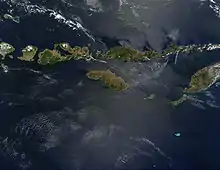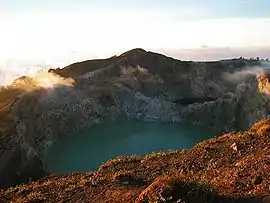Flores
Flores Island (Indonesian: Pulau Flores) is one of the Lesser Sunda Islands, a group of islands in the eastern half of Indonesia. The population was 1,831,000 in the 2010 census and the largest town is Maumere. The name Flores is the Portuguese word for "Flowers".
| Native name: Pulau Flores | |
|---|---|
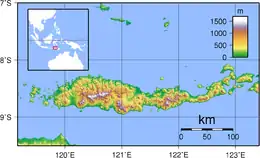 Topography of Flores | |
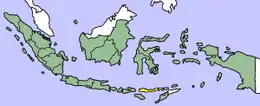 | |
| Geography | |
| Location | Oceania |
| Coordinates | 8°40′29″S 121°23′04″E |
| Archipelago | Lesser Sunda Islands |
| Area | 13,540 km2 (5,230 sq mi)[1] |
| Area rank | 60th |
| Length | 354 km (220 mi) |
| Width | 66 km (41 mi) |
| Highest elevation | 2,370 m (7780 ft) |
| Highest point | Poco Mandasawu |
| Administration | |
Indonesia | |
| Province | East Nusa Tenggara |
| Largest settlement | Maumere (pop. 70,000) |
| Demographics | |
| Population | 1,831,000 (2010) |
| Pop. density | 135/km2 (350/sq mi) |
Flores is located east of Sumbawa and Komodo islands and west of Lembata island and the Alor Archipelago. To the southeast is Timor. To the south, across the Sumba Strait, is Sumba island and to the north, beyond the Flores Sea, is Sulawesi.
Among all islands containing Indonesian territory, Flores is the 10th most populous after Java, Sumatra, Borneo (Kalimantan), Sulawesi, New Guinea, Bali, Madura, Lombok, and Timor and also the 10th biggest island of Indonesia.
Until the arrival of modern humans, Flores was inhabited by Homo floresiensis, a pygmy archaic human.
Etymology
Unlike most islands in the Indonesian archipelago, the modern name Flores was given by the Portuguese, from Cabo de Flores (Cape of Flowers), the Portuguese term for the eastern part of the island. This part of the island, originally called Kopondai, was so named by the Portuguese because of the flowering Delonix regia trees found there.[2] The original name of Flores was Nipa, referring to the serpent.
History
Homo floresiensis
Before the arrival of modern humans, Flores was occupied by Homo floresiensis, a pygmy archaic human.[3] Remains of nine individuals have been found,[4][5] and the dominant consensus is that these remains do represent a distinct species due to genetic and anatomical differences from modern humans.[6] The most recent evidence shows that Homo floresiensis likely became extinct 50,000 years ago.[7]
Modern History
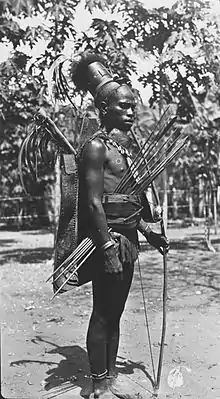
Portuguese traders and missionaries came to Flores in the 16th century, mainly to Larantuka and Sikka. Their influence is still discernible in Sikka's language, culture and religion. The first Portuguese visit took place in 1511, through the expedition of António de Abreu and his vice-captain Francisco Serrão, en route through the Sunda islands.
The Dominican order was extremely important in this island, as well as in the neighbouring islands of Timor and Solor. When in 1613 the Dutch attacked the Fortress of Solor, the population of this fort, led by the Dominicans, moved to the harbor town of Larantuka, on the eastern coast of Flores. This population was mixed, of Portuguese and local islanders descent and Larantuqueiros, Topasses or, as Dutch knew them, the 'Black Portuguese' (Zwarte Portugezen).
The Larantuqueiros or Topasses became the dominant sandalwood trading people of the region for the next 200 years. This group used Portuguese as the language for worship, Malay as the language of trade and a mixed dialect as mother tongue. This was observed by William Dampier, an English privateer visiting the Island in 1699:
These [the Topasses] have no Forts, but depend on their Alliance with the Natives: And indeed they are already so mixt, that it is hard to distinguish whether they are Portuguese or Indians. Their Language is Portuguese; and the religion they have, is Romish. They seem in Words to acknowledge the King of Portugal for their Sovereign; yet they will not accept any Officers sent by him. They speak indifferently the Malayan and their own native Languages, as well as Portuguese.[8]
In the western part of Flores, the Manggarai came under the control of the sultanate of Bima, in eastern Sumbawa; the Dutch effectively established their administration over western Flores in 1907 while in 1929, the Bimanese sultanate ceded any control over Manggarai.
In 1846, Dutch and Portuguese initiated negotiations towards delimiting the territories but these negotiations led nowhere. In 1851 Lima Lopes, the new governor of Timor, Solor and Flores, agreed to sell eastern Flores and the nearby islands to the Dutch in return for a payment of 200,000 Florins in order to support his impoverished administration. Lima Lopes did so without the consent of Lisbon and was dismissed in disgrace, but his agreement was not rescinded and in 1854 Portugal ceded all its historical claims on Flores. After this, Flores became part of the territory of the Dutch East Indies.
During World War II a Japanese invasion force landed at Reo on 14 May 1942 and occupied Flores.[9] After the war Flores became part of independent Indonesia.[8]
On 12 December 1992, an earthquake measuring 7.8 on the Richter scale occurred, killing 2,500 people in and around Maumere, including islands off the north coast.
In 2017 two men were killed in Flores due to land disputes between warrior clans; the Mbehel, a West Manggarai mountain tribe, and the Rangko from Sulawesi island who helped build Manggarai and were given land near Labuan Bajo by the Manggarai king.[10]
Administration
Flores is part of the East Nusa Tenggara province. The island along with smaller minor islands are split into eight regencies (local government districts); from west to east these are: Manggarai Barat (West Manggarai),[11] Manggarai Tengah (Central Manggarai), Manggarai Timur (East Manggarai), Ngada, Nagekeo, Ende, Sikka and Flores Timur (East Flores).[12] Flores has 39.1% of the East Nusa Tenggara provincial population as of 2010, and the most Indonesians of all islands in the province.
| Regency Name | Capital | Est. | Statute | Area (km2) | Population 2010 census[13] |
|---|---|---|---|---|---|
| West Manggarai Regency | Labuan Bajo | 2003 | UU 8/2003 | 2,947.50 | 221,430 |
| Manggarai Regency | Ruteng | 1958 | UU 69/1958 | 1,545.97 | 292,037 |
| East Manggarai Regency | Borong | 2007 | UU 36/2007 | 2,502.24 | 252,754 |
| Ngada Regency | Bajawa | 1958 | UU 69/1958 | 1,620.92 | 142,254 |
| Nagekeo Regency | Mbay | 2007 | UU 2/2007 | 1,416.96 | 129,956 |
| Ende Regency | Ende | 1958 | UU 69/1958 | 2,046.62 | 260,428 |
| Sikka Regency | Maumere | 1958 | UU 69/1958 | 1,731.92 | 300,301 |
| East Flores Regency | Larantuka | 1958 | UU 69/1958 | 1,812.85 | 232,312 |
| Flores | * | 15,624.98 | 1,831,472 |
Main towns on Flores are Ruteng, Bajawa, Ende, Maumere, Labuan Bajo and Larantuka
- Ruteng, 34 569 inhabitants
- Bajawa, 44 000 inhabitants
- Ende, 60 000 inhabitants
- Maumere, 52 921 inhabitants
Flora and fauna
The west coast of Flores is one of the few places, aside from the island of Komodo itself, where the Komodo dragon can be found in the wild, and is part of Komodo National Park, a UNESCO World Heritage Site. Kelimutu National Park is the second national park designated on Flores to protect endangered species. The Flores giant rat is also endemic to the island, and Verhoeven's giant tree rat was formerly present. These giant rodents are considered examples of island gigantism.
Flores was also the habitat of several extinct dwarf forms of the proboscidean Stegodon, the most recent (Stegodon florensis insularis) disappearing approximately 12,000 years ago.[14] The presence of Trigonoceps vultures indicates that the island bore mammalian carnivores at some point.[15]
Culture
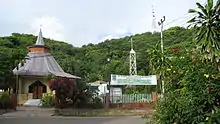

There are many languages spoken on the island of Flores, all of them belonging to the Austronesian family. In the west Manggarai is spoken; Riung, often classified as a dialect of Manggarai, is spoken in the north-central part of the island. In the centre of the island in the districts of Ngada, Nagekeo, and Ende there is what is variously called the Central Flores dialect chain or linkage. Within this area there are slight linguistic differences in almost every village. At least six separate languages are identifiable. These are from west to east: Ngadha, Nage, Keo, Ende, Lio and Palu'e, which is spoken on the island with the same name of the north coast of Flores. Locals would probably also add So'a and Bajawa to this list, which anthropologists have labeled dialects of Ngadha. To the east, Sika and Lamaholot can be found.
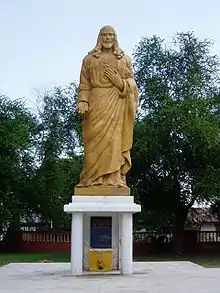
The native peoples of Flores are mostly Roman Catholic Christians, whereas most other Indonesians are Muslim. As a consequence, Flores may be regarded as surrounded by a religious border. The prominence of Catholicism on the island results from its colonisation by Portugal in the east and early 20th-century support by the Dutch in the west.[16] In other parts of Indonesia with significant Christian populations, such as the Maluku Islands and Sulawesi, the geographical divide is less rigid and Muslims and Christians sometimes live side by side. Flores thereby also has less religious violence that has sporadically occurred in other parts of Indonesia. There are several churches on the island. On 26 May 2019, Flores' St. Paul Catholic University of Indonesia was formally inaugurated by Indonesian Education Minister Mohamad Nasir, becoming the first Catholic University in Flores.[17] Aside from Catholicism, Islam also has a presence on the island especially in some coastal communities.
Tourism

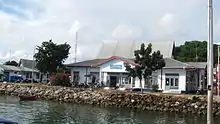
The most famous tourist attraction in Flores is the 1,639-metre-high (5,377-foot) Kelimutu volcano, containing three colored lakes, located in the district of Ende close to the town of Moni, although there is also the Inierie volcano near Bajawa. These crater lakes are in the caldera of a volcano, and fed by a volcanic gas source, resulting in highly acidic water. The colored lakes change colors on an irregular basis, depending on the oxidation state of the lake[18] from bright red through green and blue.
There are snorkelling and diving locations along the north coast of Flores, most notably Maumere and Riung. However, due to the destructive practice of local fishermen using bombs to fish, and locals selling shells to tourists, combined with the after effects of a devastating tsunami in 1992, the reefs have slowly been destroyed.
Labuan Bajo, located on the western tip is often used by tourists as a base to visit Komodo and Rinca islands. Labuan Bajo also attracts scuba divers, as whale sharks inhabit the waters around Labuan bajo.
The Luba and Bena villages include traditional houses in Flores. Bena is also noted for its Stone Age megaliths.
Larantuka, on the isle's eastern end, is known for its Holy Week festivals.
In recent years, local tourist firms around Kelimutu have begun promoting cycling tours around Flores, some of which take up to five or six days depending on the particular program.[19]
Economy
In addition to tourism, the main economic activities on Flores are agriculture, fishing and seaweed production. The primary food crops being grown on Flores are rice, maize, sweet potato and cassava, while the main cash crops are coffee, coconut, candle nut and cashew.[20] Flores is one of the newest origins for Indonesian coffee. Previously, most Arabica coffee (Coffea arabica) from Flores was blended with other origins. Now, demand is growing for this coffee because of its heavy body and sweet chocolate, floral and woody notes.[21]
Gallery
Transport
There are at least six airports in Flores distributed along the island, ordered from west to east:
- Komodo Airport in Labuan Bajo
- Frans Sales Lega Airport or Ruteng airport
- Pahdamaleda Airport or Bajawa airport
- Turelelo Soa Airport in Bajawa
- H. Hasan Aroeboesman Airport or Ende airport
- Frans Xavier Seda Airport or Maumere airport
- Gewayantana Airport close to Larantuka city.
See also
Notes
- Monk, K.A.; Fretes, Y.; Reksodiharjo-Lilley, G. (1996). The Ecology of Nusa Tenggara and Maluku. Hong Kong: Periplus Editions Ltd. p. 7. ISBN 962-593-076-0.
- Flores, Encyclopædia Britannica
- Baab, Karen L.; McNulty, Kieran P.; Harvati, Katerina (2013). "Homo floresiensis Contextualized: A Geometric Morphometric Comparative Analysis of Fossil and Pathological Human Samples". PLOS ONE. 8 (7): e69119. Bibcode:2013PLoSO...869119B. doi:10.1371/journal.pone.0069119. PMC 3707875. PMID 23874886.
- Brown, P.; et al. (27 October 2004). "A new small-bodied hominin from the Late Pleistocene of Flores, Indonesia". Nature. 431 (7012): 1055–1061. Bibcode:2004Natur.431.1055B. doi:10.1038/nature02999. PMID 15514638. S2CID 26441.
- Morwood, M. J.; et al. (13 October 2005). "Further evidence for small-bodied hominins from the Late Pleistocene of Flores, Indonesia". Nature. 437 (7061): 1012–1017. Bibcode:2005Natur.437.1012M. doi:10.1038/nature04022. PMID 16229067. S2CID 4302539.
- Argue, Debbie; Groves, Colin P. (21 April 2017). "The affinities of Homo floresiensis based on phylogenetic analyses of cranial, dental, and postcranial characters". Journal of Human Evolution. 107: 107–133. doi:10.1016/j.jhevol.2017.02.006. PMID 28438318.
- Sutikna, Thomas; Tocheri, Matthew W.; Morwood, Michael J.; et al. (2016). "Revised stratigraphy and chronology for Homo floresiensis at Liang Bua in Indonesia". Nature. 532 (7599): 366–369. Bibcode:2016Natur.532..366S. doi:10.1038/nature17179. hdl:1885/109256. PMID 27027286. S2CID 4469009.
- Fox, James J. (2003). "Tracing the path, recounting the past: historical perspectives on Timor". In Fox, James J.; Soares, Dionisio Babo (eds.). Out of the Ashes: Destruction and Reconstruction of East Timor. ANU E Press. doi:10.22459/oa.11.2003.01. ISBN 978-0-9751229-1-4.
- L, Klemen (1999–2000). "The Lesser Sunda Islands 1941–1942". Forgotten Campaign: The Dutch East Indies Campaign 1941–1942.
- "Deadly trouble for surf pioneer in Indonesia's new paradise". The Australian. 28 January 2017. Retrieved 17 October 2018.
- Manggarai Barat District includes islands like Komodo and Rinca to the west of Flores
- Flores Timur District includes islands like Adonara and Solor to the east of Flores.
- "Hasil Sensus Penduduk 2010". Ntt.bps.go.id. Retrieved 25 July 2012.
- Van Den Bergh, G. D.; Rokhus Due Awe; Morwood, M. J.; Sutikna, T.; Jatmiko; Wahyu Saptomo, E. (2008). "The youngest Stegodon remains in Southeast Asia from the Late Pleistocene archaeological site Liang Bua, Flores, Indonesia". Quaternary International. 182 (1): 16–48. Bibcode:2008QuInt.182...16V. doi:10.1016/j.quaint.2007.02.001.
- Meijer, Hanneke J.M.; Tocheri, Matthew W.; Due, Rokus Awe; et al. (2015). "Continental-style avian extinctions on an oceanic island" (PDF). Palaeogeography, Palaeoclimatology, Palaeoecology. 429: 163–170. doi:10.1016/j.palaeo.2015.03.041 – via repository.si.edu.
- Steenbrink (2013)
- Dagur, Ryan (28 May 2019). "Indonesia inaugurates first Catholic university in Flores". La Croix International.
- Pasternack. Keli Mutu Volcanic Lakes Archived 2 February 2017 at the Wayback Machine, University of California Davis.
- Makur, Markus (13 March 2016). "Bicycle tours of Kelimutu boost local economy". The Jakarta Post.
- East Nusa Tenggara, Indonesian Chamber of Commerce and Industry. Retrieved 8 August 2008.
- Arabica Producing Regions of Indonesia, Specialty Coffee Association of Indonesia. Retrieved 8 August 2008.
References
- L, Klemen (1999–2000). "Forgotten Campaign: The Dutch East Indies Campaign 1941–1942". Archived from the original on 26 July 2011.
- Steenbrink, Karel (2013). "Dutch Colonial Containment of Islam in Manggarai, West-Flores, in Favour of Catholicism, 1907–1942". Bijdragen tot de Taal-, Land- en Volkenkunde. 169 (1): 104–128. doi:10.1163/22134379-12340024.
External links
| Wikivoyage has a travel guide for Flores (Indonesia). |
 Media related to Flores, Indonesia at Wikimedia Commons
Media related to Flores, Indonesia at Wikimedia Commons- Flores & Komodo – History
